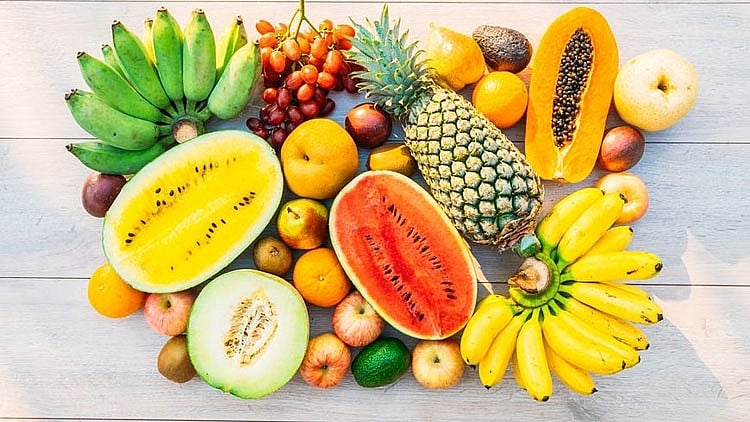
Vietnamese fruit has long been a profitable export as well as an effective feature to attract numerous international visitors in terms of Vietnam travel. When coming to Vietnam, it is as important to enjoy some local fruits as it is to enjoy Pho - a Vietnamese signature dish. Hence, let’s dive right into a paradise of fruits to fulfill your trip to Vietnam.
1. Vietnamese Jackfruit (Mít)
Jackfruit is among the most popular Vietnamese fruits. These oblong-shaped fruits can grow up to 90 centimeters long and weigh 10–20 kilograms per fruit. Jackfruit always makes an impressive sight whenever displayed in fruit stalls because of its green or yellowish-colored crust with numerous sharp hexagonal spines.
Inside the jackfruit are loads of fleshy yellow bulbs with attractive fragrances and a sweet taste, along with a crunchy, stringy texture. In addition, jackfruit is rich in vitamin C as well as other nutrients that are beneficial for your whole body.
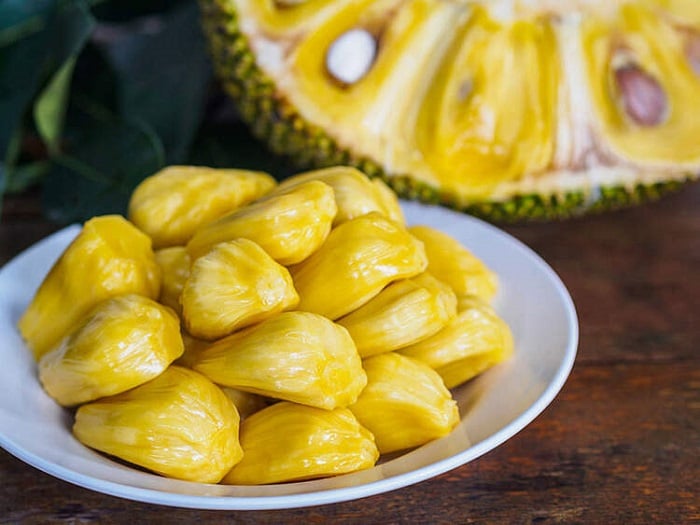
How to eat: Jackfruit is perhaps the hardest fruit to open on this list, due to its rough skin and sticky latex. So better use gloves or a towel to remove the shell easier. You can enjoy jackfruit in various ways, such as by mixing it with yogurt, coconut cream, or other fruits.
2. Vietnamese Dragon Fruit (Thanh long)
This strange Vietnamese fruit can be found in the Mekong Delta. Its name comes from its bright red skin and many green scales that resemble the dragon’s scales. Inside the Vietnamese dragon fruit is white or red flesh and contains lots of edible black seeds.
The fruit has a refreshing taste with a perfect mixture of sweet and sour. It is considered a nutrient-dense fruit with low calories and is rich in fiber, magnesium, and vitamin C, which help prevent cancer, premature aging, etc.
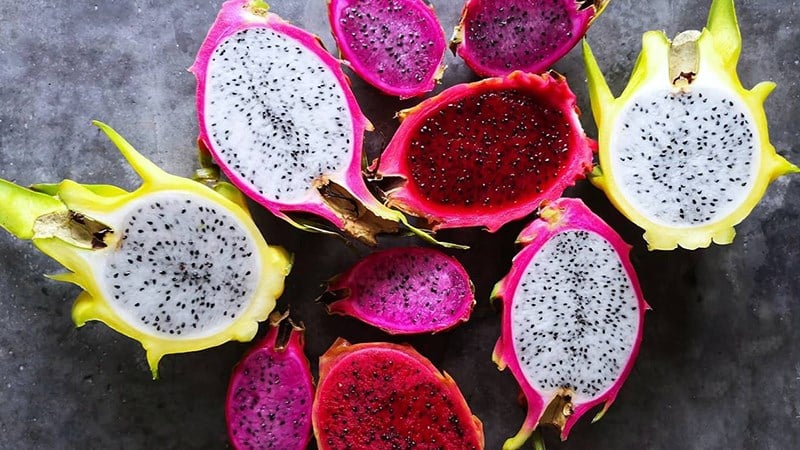
How to eat: Dragon fruit itself has very soft and thin skin, so all you need to do is slice it into smaller portions to enjoy, then peel the skin off of the flesh and savor the gentle taste. It is a healthy dessert favored by many Vietnamese people.
3. Star Apple (Vú sữa)
Star apple, or Milk fruit, is a succulent fruit widely grown in provinces of the Mekong Delta. The Vietnamese name of this fruit is translated to “breast milk”, which is related to an old folktale.
The fruit is close to the size of an orange, with a thin and shiny skin in a light green or purple color. The white pulp inside has a star pattern holding large, inedible seeds. Its unique mellow taste with super juicy and fragrant meat will surely make you mouth-watering.
How to eat: Vietnamese star apple is a highly nutritious fruit that contains vitamins A, C, and B, as well as calcium. It is recommended to eat star apples daily. Simply cut the fruit in half and use a spoon to scoop out the meat, like a local.
4. Guava (Ổi)
Guava is a popular Vietnamese fruit that can be served as a dessert, side snack, or supper. Vietnamese guava can be harvested in the Mekong Delta or in northern provinces like Thai Binh, Bac Giang, Ha Noi, and Hung Yen.
Its shape is pretty similar to that of a pear, but it is bumpier and has a lighter green skin that is edible when carefully washed. You will be totally into the crunchiness and sweetness with a little bit of sourness of the white or pink meat, including countless hard, tiny seeds.
How to eat: As all parts of the guava are edible, you only have to rinse them, cut them into small pieces and dip them in chili salt, which creates the perfect combination of flavors - sweet, sour, salty and a touch spicy.
5. Lychee (Vải)
Lychee is among the top Vietnamese fruits in summer. In Vietnam, the provinces of Hai Duong and Bac Giang are well-known for their delicious lychee varieties.
Lychee has a pretty round shape with rough red or pinkish-red skin. Its core consists of a thick and juicy pulp surrounding a hard brown seed. Its flavor is described as a mix of strawberry and watermelon. Its sweetness and freshness are really addictive; hence, lychee is one of the most preferred fruits in Vietnam when summer arrives.

How to eat: You peel off the outer skin and enjoy the luscious pulp while removing the seed. Lychee provides vitamin C, antioxidants, fibrous, etc. that benefit your immunity and prevent cancer.
>>> Read more: Vietnamese food: The TOP 10 must-try dishes in 2023
6. Sapodilla (Hồng xiêm)
This delicious fruit is hardly found in Western countries but is a native Vietnamese fruit, especially in the North. The fruit has the shape of an egg and a thin, brownish skin.
Its appearance is somehow tedious, yet the flesh is super soft and sweet, which will definitely satisfy your taste. Sapodillas cannot be eaten when unripe since the flesh is still hard and contains latex.
How to eat: First, you wash the sapodilla with water to get rid of the dust, then peel off the skin and divide it into 4 or 6 parts. Sapodilla can be eaten directly or incorporated into smoothies.
7. Java Apple (Roi)
Java apple, an unusual Vietnamese fruit, has a shape that resembles a bell. The outside layer of it is smooth, shiny, red-colored, and comes with a watery texture just like watermelons.
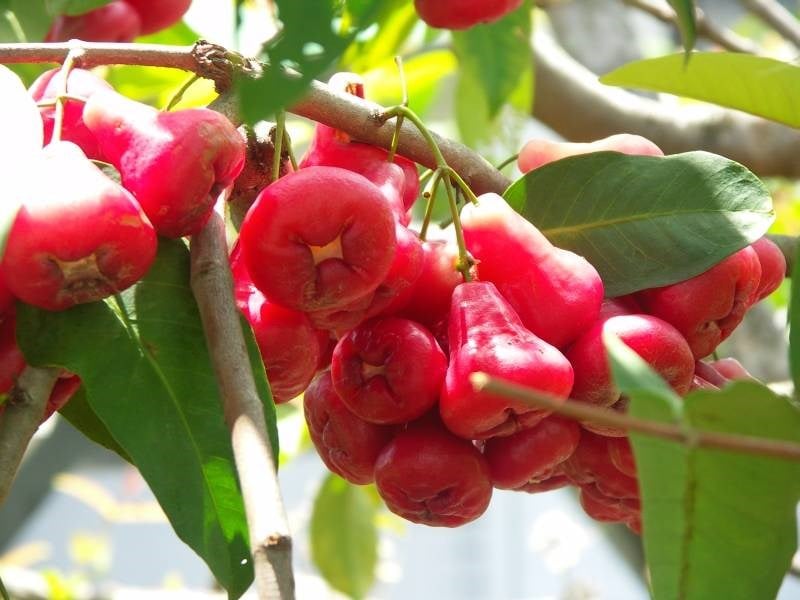
It is so juicy and crunchy and tastes so sweet that you just want to keep munching it. Also, the nutritional components of the java apple are beneficial to the digestive and immune systems.
How to eat: Basically, you remove the bottom part and eat around the core (avoid the seeds inside) or slide it in half and take out the core, then dig in.
8. Must-try Vietnamese fruits? Rambutan (Chôm chôm)
In terms of Vietnamese fruits, rambutan is among the must-try fruits when you pay a visit to Vietnam. The unique name comes from the word “Rambut” in Malay, which means “hair”.
Their vibrant and hairy crust embraces white translucent flesh with a light sweet and sour flavor like grapes. Big bunches of these eye-catching fruits can be easily found on every food stall or street vendor during the summer.

How to eat: You may need a knife to break the skin in half, enjoy the delectable flesh, and throw away the seed. Vietnamese fruit markets sell lots of rambutan at an affordable price, and this fruit is also a great source of vitamin C and fiber.
9. Custard Apple (Na)
Custard apples are another popular Vietnamese fruit. It mostly appears in round or heart shapes, and the skin is green with cracked grooves on the surface. When they get riper, the shells expand and the grooves get larger and sometimes reveal the white meat inside.
The flesh has such a delicate and sweet flavor and an extremely soft texture. However, the fruit contains a large number of seeds, so you have to remove them while eating custard apples.
How to eat: Gently peel off the skin and immediately dig in or eat the flesh with a spoon. This scrumptious fruit is high in proteins and vitamins and is also presented in the five-fruit tray during the Tet holiday in Vietnam.
10. Soursop (Mãng cầu)
Soursop is a fruit with a delicious aroma and taste that is famous among both Vietnamese and foreigners. Unlike the sweetsop fruit (or so called sugar apple), soursops are larger in size, have an oval shape, and a darker green color than sweetsops.
The white flesh inside has an attractive aroma that can remind you of pineapple. As for its sweet and sour taste, soursop is usually used to make fresh smoothies, ice cream, juice, etc. Soursop's high vitamin and mineral nutrients will help to improve overall health.
How to eat: Rinse the fruit carefully for a few minutes. Then peel off the layer and take out the stem and inner core. Finally, chop the fruit into small pieces to enjoy.
>>> Read more: Vietnam where to go: The 10 HOTTEST destinations in 2023
11. Vietnamese Passion Fruit (Chanh leo)
This small, round, purple fruit is an essential ingredient in Vietnamese cuisine. The yellow flesh inside is super juicy with numerous edible seeds, delivering a sour taste with a little bit of sweetness.
Plenty of Vietnamese mouth-watering dishes, including ice cream, refreshing juice, cocktails, cakes, etc., are made from passion fruit. It contains a great deal of vitamin C, proteins, and carbs.
How to eat: Simply use a knife to pull apart the thick rind and a spoon to scoop out the flesh inside to create fresh drinks or tasty food.
12. Mangosteen (Măng cụt) - Among popular Vietnamese tropical fruits
Mangosteen is one of the most exotic fruits you'll find in Vietnam, and it's only available from April to July. Mangosteens, with their thick purple rind and soft, tangy flesh, are widely available in supermarkets and from street vendors throughout Vietnam.
The flesh is divided into segments with or without seeds inside. These pulps are tender and sweet with a little mix of sour. When tasting it, you will be totally immersed in its softness and succulence.
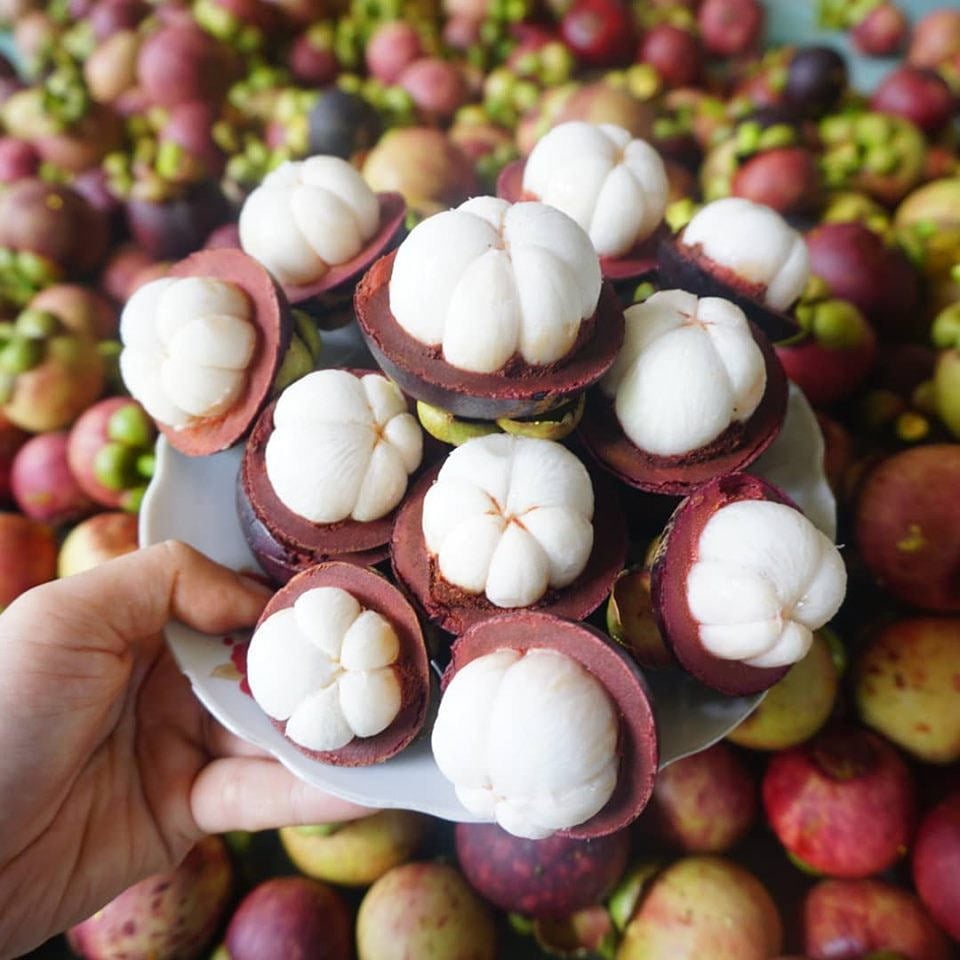
How to eat: The best way is to cut the thick rind apart with a knife, take the flesh out, and let the taste mesmerize you! Be careful with the seeds while eating mangosteen.
13. Ambarella (Quả cóc)
Ambarella is a fruit that all Vietnamese are familiar with. It is a necessary component of Vietnamese cuisine.
The Vietnamese ambarella comes in a bunch and has an oval shape. Immature ambarella typically has green and troublesome skin. The center contains a fibrous pit. The fruit will turn a light yellow color when ripe. Its flesh is extremely crunchy, with a sweet and sour taste.
How to eat: Remove the skin, cut it into pieces and get rid of the seed. Local Vietnamese often enjoy raw ambarellas with salt and chili. It is also pickled with sugar and saltwater.
14. Longan (Nhãn)
What a shortcoming if we do not mention Vietnamese longan. It is well-known in many tropical countries and appears in several provinces of Vietnam, such as Hung Yen, Can Tho, and Vinh Long.
Longan is also called “dragon’s eye” in Vietnamese due to its round black seed resembling an eyeball, embraced by a fleshy, translucent pulp. The pulp has a lovely sweet flavor and luscious texture, which is a refreshing treat in summer.
How to eat: Peel off the smooth brown cover, and you will see the succulent flesh. Not only are longans delectable, but they are also a good source of nutrients like vitamins, proteins, and calcium.
15. Durian (Sầu riêng) - A special Vietnamese fruit from the Southern region
Durian, or so-called the “King of Fruits” in some Southeast Asian countries, including Vietnam, is a famous fruit for its special aroma and exceptional flavor.
Durian’s appearance is similar to that of jackfruit, yet the spikes are bigger and can wound your skin if you are careless. Contrary to the thick and hard crust, the meat inside has a custard-like texture that immediately melts in your mouth. The flavor of durian is a one-of-a-kind combination of sweetness, saltiness, and creaminess.
How to eat: In case you get hurt by durian spikes, wear gloves and use a sharp knife to separate the fruit's crust and take out the yellow flesh to enjoy.
>>> Read more: Vietnam hotels: The TOP 14 options for a fabulous stay with your family
16. Star Fruit (Khế)
This interesting star-shaped fruit is widespread in numerous countries around the world. It can be harvested year-round in Vietnam.
Star fruit is refreshing and juicy when ripe and golden, with a sweetish sour taste. Its flesh is covered by a thin and waxy skin, which is edible. It is usually orange or yellowish in color. The fruit has around 5 longitudinal segments, so you will get beautiful star-shaped slices if cutting horizontally.
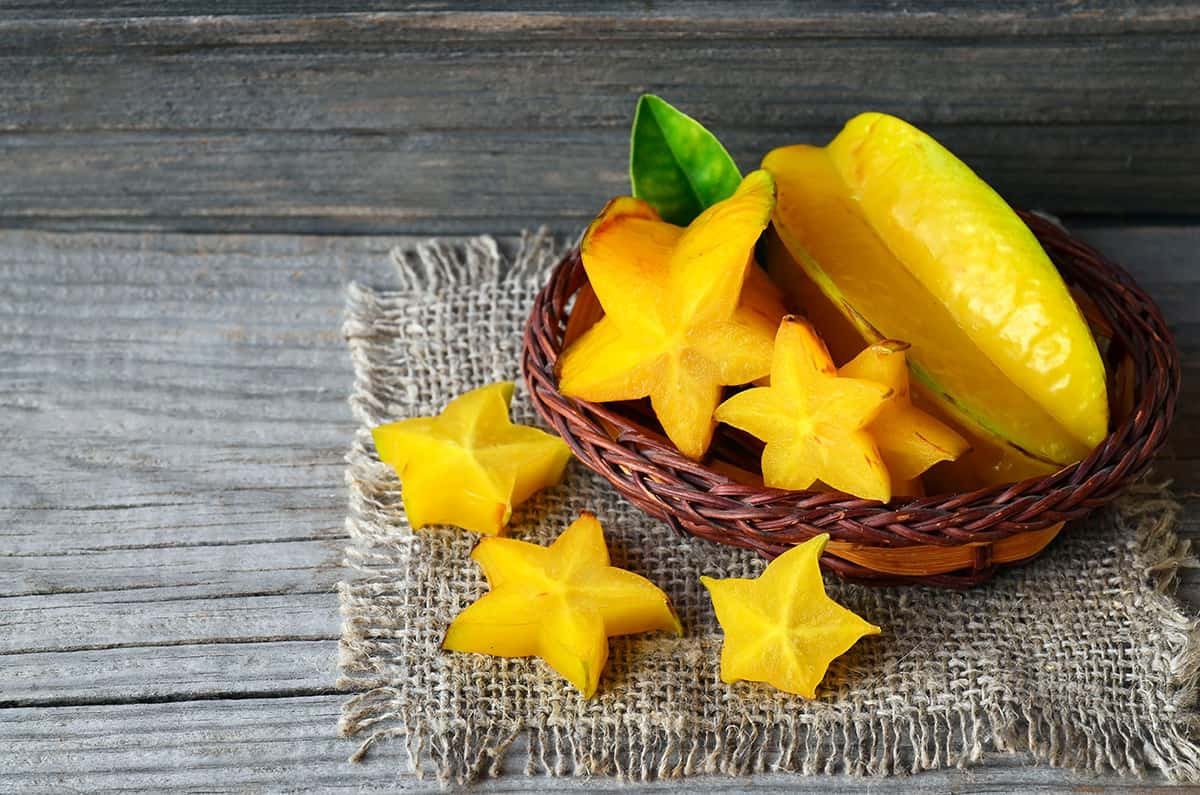
How to eat: Rinse the starfruit thoroughly and slice it horizontally or vertically, the seeds inside are also edible. But if you prefer your fruit seedless, you can gently squeeze it to remove them. Vietnamese star fruit is often used to make salads, desserts, or mixed with veggies as a side dish.
17. Langsat (Dâu da đất)
Langsat, one of the delicious Vietnamese tropical fruits, is widely harvested in most of the provinces in Vietnam. Langsat’s shape varies from round, elliptic, to oval. The outer skin is velvet-felt with a yellow color and dark speckles, which is described as a mini potato.
The flesh is translucent and shiny. It is separated into 5 or 6 parts, each with its own seed. Despite their tiny size, langsats contain numerous vitamins and fiber that benefit your health.
How to eat: Start with the bottom of the fruit to peel it off and munch around the seed. Langsat has a mild sweet and sour flavor with lots of juice inside that resembles grapes.
18. Papaya (Đu đủ)
Not only is papaya a fresh fruit to eat, but it is also a necessary ingredient in Vietnamese dishes and appears in the five-fruit tray on Tet holiday. It is a common Vietnamese tropical fruit that has an eye-catching yellow or orange colored flesh. When ripe, the flesh is super soft and tender, bringing out a fresh, saccharine taste.
The center of the flesh carries countless inedible seeds and should be removed before eating. You will earn a lot of valuable health benefits from papayas, such as vitamins, calcium, fiber, etc.
How to eat: Use a knife to peel off the skin, then cut the papaya into cubes or slices to enjoy. As the fruit can go bad quickly, store it in the fridge to maintain its freshness.
19. TOP 20+ exotic Vietnamese fruits? Nipa Palm (Dừa nước)
If you have ever traveled along the Mekong Delta river banks, you can easily spot the Nipa Palm emerging copiously from the water.
Nipa palm grows in bunches, with small nipa palm fruits sticking together.
The crust outside is dark brown and shaped like a drop of water, while the pulp inside is just like an egg. The pulp is white or translucent with an extremely soft, smooth texture that you can scoop out with ease. Its sweetness is the perfect ingredient for dessert and can make you addicted.
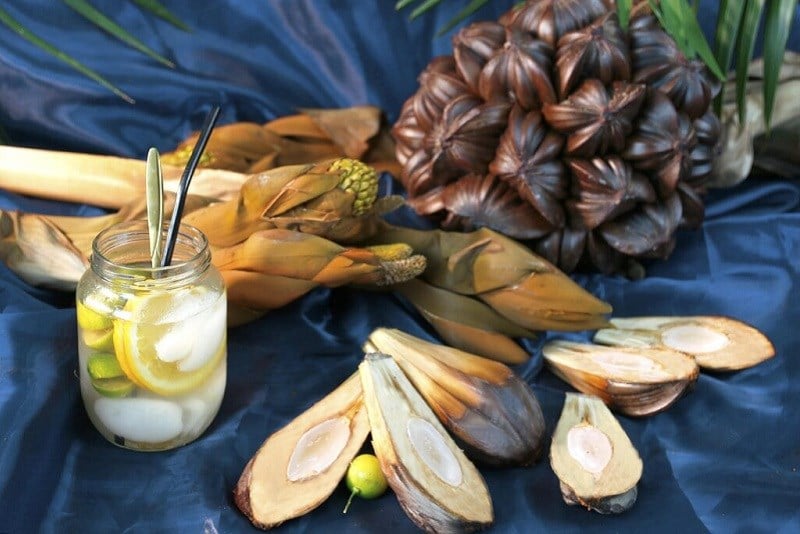
How to eat: Cut the fruit in half and the white pulp will reveal, you just simply use a spoon to get the flesh out and enjoy.
>>> Read more: Vietnam things to do: 10 MUST-HAVE experiences on a First Visit
20. Pomelo (Bưởi)
Pomelo belongs to the citrus family and has a close relationship with grapefruit. This fruit is indigenous to Southeast Asia and has thick, spongy green or yellowish skin.
Once you cut the pomelo open, a thick white pith appears, obstructing the pale yellow or pink flesh. The flesh is made up of countless succulent cells filled with juice. Its taste may be a little bit more bitter than grapefruit but also has a sweetener flavor.
How to eat: You need to cut off the thick layer first to only leave a thin layer of the pith, then slice it into two parts and split each piece of flesh to eat.
21. Persimmon (Hồng)
There are two types of Vietnamese persimmon: the ripe persimmon (hồng chín) and the crunchy persimmon (hồng giòn).
The ripe persimmon is bigger than the crunchy persimmon, with a thin bright-red colored skin. The meat inside is super soft and immediately melts in your mouth.
The crunchy persimmon is smaller, yet harder and crunchier than the ripe one. It has a bright orange color with a sweet flavor. Whether the persimmon is ripe or crunchy, they will all be very palatable to eat.
How to eat: Peel off the skin and divide it into smaller pieces to consume. Both types of persimmons provide health-promoting benefits for your body.
In addition to a wealth of Vietnamese exotic fruits, it is a must that you also try Vietnamese food to indulge your taste. Several well-known tourist hubs in Vietnam that are highly recommended for the best food and entertainment are Phu Quoc, Hoi An, Da Nang, Nha Trang, Ha Long, etc. Hence, choosing flawless accommodation is essential. Let’s check out Vinpearl, the top hospitality brand with a series of brilliant hotels and resorts in many tourist attractions that will provide you with the finest service and a comfortable stay. Here are some of the top-notch hotels and resorts of Vinpearl:


>>> Book rooms in Vinpearl Phu Quoc, Vinpearl Nha Trang, Vinpearl Resort & Golf Nam Hoi An, Vinpearl Resort & Spa Ha Long to get the best access to superior service and cuisine
Vietnamese fruits play an indispensable role in the everyday lives of the locals. Besides being delectable desserts, Vietnamese fruits also appear in numerous Vietnamese cuisines and carry cultural values. So, this is your sign now to discover Vietnamese tropical fruits, and you will surely fall in love with some of them!
























